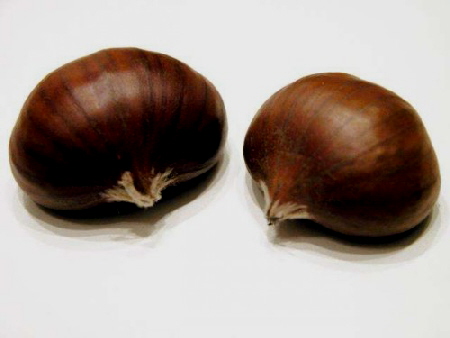|
CHESTNUTS >> Kindred Duty of Care for Children
 In his journey to the people of the Iron Age, Swedenborg approached them, with the accompanying angel, through “a forest consisting of beeches, chestnuts, and oaks” (Conjugial Love #78). These seem to have been situated between the people of the Copper Age and those of the Iron, and to have partaken of the quality, at least as to the beeches, of the nobler age; for the Iron people did not live in singleness of marriage. So likewise in approaching the men of the Copper Age, he entered their heaven from the south, where he found “a magnificent grove of palms and laurels,” which certainly partake of the intelligent quality of the earlier Silver Age. In his journey to the people of the Iron Age, Swedenborg approached them, with the accompanying angel, through “a forest consisting of beeches, chestnuts, and oaks” (Conjugial Love #78). These seem to have been situated between the people of the Copper Age and those of the Iron, and to have partaken of the quality, at least as to the beeches, of the nobler age; for the Iron people did not live in singleness of marriage. So likewise in approaching the men of the Copper Age, he entered their heaven from the south, where he found “a magnificent grove of palms and laurels,” which certainly partake of the intelligent quality of the earlier Silver Age.
The statement first mentioned is interesting from its association of the chestnut and the oak with the beeches. They form one family, with marked differences. The chestnut, which comes nearest to the beech, is distinguished from it for our purpose by the irregular number of nuts, from one to three in each bur, by the larger size of the nuts, and by the smaller quantity of oil in them. The trees are cultivated for their fruit and also for their wood, which is less solid than that of the beech, but is exceedingly durable, especially, as compared with other hardwoods when in or near the ground; for which reason it is much used for fences and for sills of houses. It evidently represents some kind of knowledge of natural life. And as the pair of oily beech nuts represent a knowledge of the duty of singleness in marriage, the chestnuts, of indefinite number, may represent the kindred duty of care for children.
The warmly lined bur, so soft within and prickly without, suggests a comfortable and well-protected home; and is a very perfect representative of the paternal feeling which would guard the children from every hurtful approach till they arrive at maturity. This is very similar to the instinct of protection around one’s marriage life, as the bur of the chestnut resembles that of the beech.
The sharp angles of the beech nut indicate the perfect definiteness of the law of singleness which it represents; and the rounder, more irregular forms of the chestnuts express the greater indefiniteness and variety of principles of education.
The wide spread of the branches, and the extreme age of some chestnuts, shows the comprehensiveness and permanence of some principles of education. The durability of the wood in the ground represents the endurance of the principles when exposed to the experiences of the world—parents carrying out good principles for their children’s sake much more patiently than they will for their own; whence their use as foundation timbers for our homes.
Author: JOHN WORCESTER 1875
|